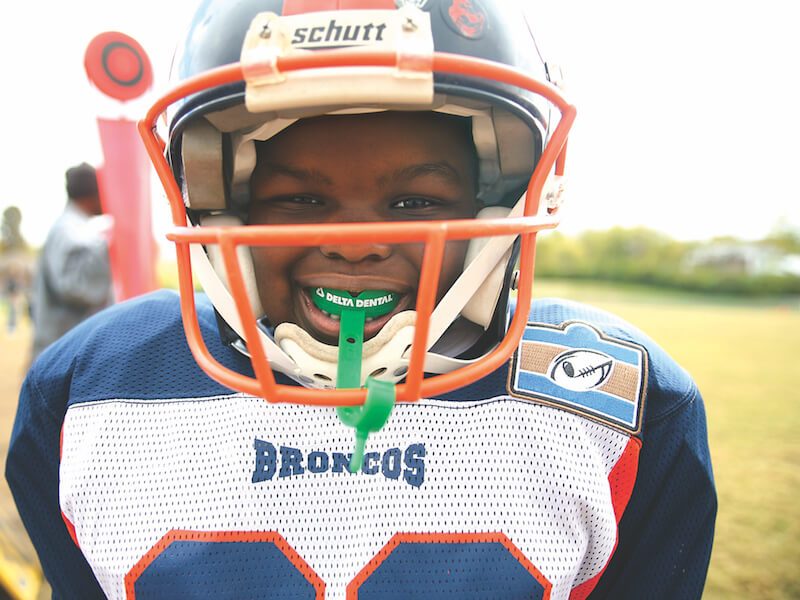Make a Mouthguard Part of Your Uniform
By Jill Feilmeier on March 23, 2017 in Kid's Health
 Helmet? Check.
Helmet? Check.
Jersey? Check.
Knee pads? Check.
Footwear? Check.
Mouthguard? Check!
Mouthguards typically cover your upper teeth and protect your teeth, lips, tongue, face and jaw against injuries, so they need to be part of your uniform in any sport or recreational activity you play.
“It’s important to take care of your mouth and teeth both on and off the field, court, rink, ring or trail,” says Dr. Jeff Chaffin, dental director for Delta Dental of Iowa. “Kids and adults who are involved in all types of recreational activities can benefit from using mouthguards. Being cautious with the only set of permanent teeth you will ever have is always a smart choice.”
Team sports or other activities such as skateboarding, biking and martial arts pose the risk of injury to the teeth, jaw and oral soft tissues (mouth, lip, tongue, or inner lining of the cheeks). While mouthguards may not be required for the activity or sport and can sometimes be expensive, it’s a good idea to ask your dentist about the risks of not wearing a mouthguard and what some of the long-term costs might be in the event of injury.
Types of Mouthguards
The best mouthguard is one that has been custom made for your mouth by your dentist. However, if a custom-made mouthguard is not in the budget, you should still wear a stock mouthguard or a boil-and-bite mouthguard. Learn more about each mouthguard option:
- Custom-made: These are made by your dentist for you personally. They are more expensive than the other versions because they are individually created for fit and comfort.
- Boil and bite: These mouth protectors can be bought at many sporting goods stores and drugstores and may offer a better fit than stock mouth protectors. They are first softened in water (boiled), then inserted and allowed to adapt to the shape of your mouth. Always follow the manufacturers instructions.
- Stock: These are inexpensive and come pre-formed, ready to wear. Unfortunately, they often don’t fit very well. They can be bulky and can make breathing and talking difficult.
Mouthguard Care and Replacement
Talk to your dentist about when it’s the right time to replace your mouthguard. As a good rule of thumb: replace it immediately if it shows sign of wear, is damaged or ill fitting. Teens and children may need to replace their mouthguards more often because their mouths are still growing and changing.
Between uses, it’s important to keep your mouthguard clean and dry. Here are some tips for making sure your mouthguard is always ready to go:
- Rinse before and after each use or brush with a toothbrush and toothpaste.
- Regularly clean the mouthguard in cool, soapy water. Then, rinse it thoroughly.
- During your regular dental checkups, bring your mouthguard for an evaluation.
- Store and transport the mouthguard in a sturdy container that has vents so it can dry and keep bacteria from growing.
- Never leave the mouthguard in the sun or in hot water.
- Some mouthguards have fallen victim to family pets, who see them as chew toys. Store your mouthguard and case somewhere your pet cannot get to it.
Protect that smile.
Dental health can be a critical step to a child’s overall health. Forming daily habits of brushing and flossing helps maintain bright smiles and healthy bodies.
Schedule regular dental visits and bring your mouthguard so that your dentist can make sure it still fits properly and is in good condition. It is never too early to start wearing a mouthguard. As soon as you begin to look into sporting activities for you or your child, talk with your dentist. Good habits start early, and use of a mouthguard by children and teenagers will promote and reinforce use later in life.
1. http://www.mouthhealthy.org/en/az-topics/m/mouthguards
2. http://www.ada.org/en/member-center/oral-health-topics/mouthguards
3. http://www.mouthhealthy.org/en/az-topics/m/mouthguards
4. http://jada.ada.org/article/S0002-8177(14)61012-6/fulltext